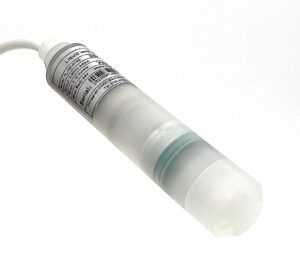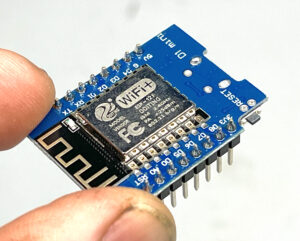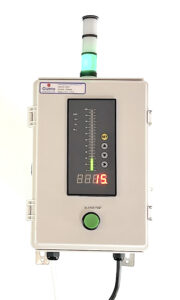DIGITAL TANK LEVEL GAGE displays liquid level and give alarms if level is out of range.
Liquid level gage for tanks displays the level in the tank with a bar graph and numerical display.
The sensor responds to changing liquid level by indicating with a bar graph and numerical reading. It can work using either a radar sesnor or a submersible pressure sensor.
There are four independent alarm points that can be configured many different ways. For example there could be a H, HH, L and LL events. These are indicated with the LEDs on the panel. In addition the stack light will indicate all of these in any order. For example the yellow stack LED could indicate only the H alarm. In addition, any of the action points can generate another signal for other actions like a text message or email, or communication to a building alarm system.
SENSORS
We offer two types of sensors to determine liquid level: Radar, and submersible pressure. We don’t deal in unreliable ultrasonic sensors, or other technologies. Both Radar and submersible pressure are very reliable. Radar has the advantage that it is non-contact whereas the sumbersible pressure sensor needs to be placed at the bottom of a tank and connected to the level gauge by a cable.
RADAR
Radar sensors measure liquid depth by sending electromagnetic waves of energy down to the liquid surface. The time it takes for the waves to bounce back is directly related to the depth of the liquid. Radar sensors are know for high accuracy and reliability. They are known for their success in challenging environments that might include vapour, gases, temperature variations, extreme temperatures, extreme dust, wind, or foam. This is becuase the signal reflects best from materials that have a high dielectric constant. In fact, they will even sense through low-dielectric materials like plastics. So if the tank is plastic, then the tank could be monitored without even needing a hole in the tank!
SUBMERSIBLE SENSOR
Submersible pressure sensors work by measuring the hydrostatic pressure on the sensor due to the weight of the liquid above it.This an established technology noted for its high reliability, low installation cost, and simple engineering. Submersible level sensors may be used in almost all liquid media, from aggressive chemicals to pastes and sludges, providing reliable level measurement in the most challenging conditions.
hydrostatic pressure on the sensor due to the weight of the liquid above it.This an established technology noted for its high reliability, low installation cost, and simple engineering. Submersible level sensors may be used in almost all liquid media, from aggressive chemicals to pastes and sludges, providing reliable level measurement in the most challenging conditions.
Submersible sensors are immune to turbulence, foam, fouling, obstructions. They don’t need to be tuned or calibrated, and they don’t need to be carefully positioned. Finally, there is no “dead zone” to worry about. The downside is that the cable is vulnerable in agitated tanks.
The default mounting in the tank is through a tank bushing in the top of the tank. (2″ NPT)
Instructions for LG-S submersible sensor
Instructions for LG-R with Radar sensor.
Detailed manual for the RADAR sensor from the manufacturer.
Detailed manual for the digital display from the manufacturer.
ENCLOSURE
- Enclosure material………………………….. ABS
- Buzzer volume…………………………………103dB @ 2ft.
- Operating temp………………………………. -40 to 60ºC (-76-140ºF)
- Ingress protection……………………………. IP65
- Stack light material……………………….Lexan
- Dimensions……………………………….11.2 x 7.7 x 5.1 inch
- Mounting tabs…………………………….304 SS
- ENCLOSURE DRAWING
DIGITAL DISPLAY GAUGE
- Accuracy…………………………………±0.5%
- Output available (term 9,10)……………4-20mA
- Relay outputs……………………………3A
- Power consumption……………………<5W
- Load resistance…………………………DC 4-20mA <500Ω
RADAR SENSOR
- Maximum sensing distance……………65m
- Accuracy…………………………………2% F.S.
- Housing………………………………… anodized aluminum
- Output……………………………………4-20mA
- Weight……………………………………350g
- Frequency ………………………………78GHz
- Voltage ………………………………… 24VDC
- Beam angle…………………………… 6º
- Diameter…………………………………76mm
SUBMERSIBLE SENSOR
- Housing and cable material……………PTFE
- Diaphragm………………………………ceramic
- Diameter…………………………………30 mm
- Length……………………………………140 mm
Link to submersible sensor datasheet
PTFE housing and cable with titanium diaphragm will resist almost any chemical. temperature. Click here for chemical resistance chart
ORDER HERE
Options
Extra cable
(applies to LG-S only) Extra cable length over the standard length of 10 feet that’s included. Heavy 0.032″ jacket for superior durability. Four stranded conductors x 24 gage.
[C4] $1.28/ft
WIFI communication

Sends a message to your email or text message to your phone using exsisting WIFI. Easy setup. No recurring fees. More info.
[WF-1] $195




